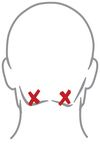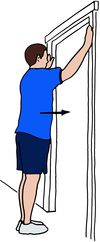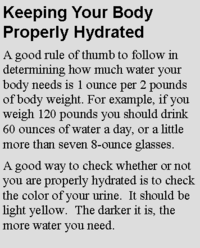Where Do You Hold Your Tension
Suzanne Mintz
Stress is synonymous with family caregiving, although we all deal with it
differently and our bodies react to it in different ways. Research has shown
that family caregivers age prematurely, are more likely to experience
depression, and are at risk for their own chronic conditions. How our bodies
hold tension is a separate matter entirely.
Samson Moy has a degree in kinesiology (the study of human movement) and is a
certified massage therapist and strength and conditioning specialist in
Kensington, Maryland. We asked Sam to explain how tension forms in our bodies
and what easy things we can do almost anywhere to release that tension. Here’s
what he had to say:
Sam: The two most abundant ingredients in our bodies are
blood and water. Think of your veins and arteries as the body’s rivers for
carrying nutrients to, and waste away from, the muscles. When our muscles
function properly, they are loose and blood and water flow freely through them;
but when our muscles malfunction, they are tense with less fluid. Adhesions
(“knots”) can form in the muscle fibers and fascia (connective tissue that
surrounds muscles) when muscles become overworked, which, in turn, can cause
pain.
Suzanne: Sometimes your body can be tight, but you can’t
locate a specific pain point. It’s as if there is a general tightness across
your entire body. What causes this?
Sam: You can be carrying tension in your body without even
realizing it. Posture plays a big part in neck and back tension. It is a natural
tendency to lean forward; as we age, this tendency increases. It’s made worse by
the fact that so many of us spend a good part of our days sitting at a desk and
leaning over a computer. At first you may not feel pain but only a little stiff.
As your tension increases and it becomes harder for the flow of blood and water
to make it through tight spaces, the stiffness increases to such an extent that
it manifests itself as pain.
Suzanne: Are there places in the body that are more likely
than others to generate tension pain?
Sam: Yes, there are pressure points (professionals tend to
use the terms “trigger points” or “tie-ins”) where a bundle of nerves and
muscles come together. These are the areas where tension is concentrated. It’s
important to know this because it’s possible to release tension by applying
pressure directly to these points. There are a great many trigger points in the
body and they are easy to find. Pay the most attention to the ones noted in the
diagram below.
Suzanne:
You identify pressure points that are located at the back of the head. For some
of us, headaches are our body’s way of responding to stress. Before we reach for
a painkiller in a bottle, is there something else we can do to try to cure the
headache?
Sam: Yes, there is. You can try applying pressure to the
trigger points located at the base of the skull on either side of your head.
A headache in the front of your head can actually be caused by muscle
tension in your upper neck at the base of the skull. To locate that trigger
point, put your thumb midway up the back of your head. Slowly move it down until
you find the top of the indention, move to the right and put your thumb on the
trigger point. You’ll know when you have found it because it will be sensitive
to your touch. Using the weight of your head, lean back on your thumb to
increase the pressure. Hold as long as you can. Repeat two or three times.
Repeat on the left side. While this technique isn’t foolproof, it does work much
of the time.
Suzanne: Are there other things we can do to get rid of pain
and tightness?
Sam: Most people carry a significant portion of their stress
in their shoulders, neck and back, or at least that is where we feel it. A lot
of the actual tightness comes from the pectoral muscles located in our
chest.
A majority of the time, the pain we feel in a specific part of our body is
caused by muscles on the other side — for instance, pain in your neck is
associated with muscles in your chest.
An easy thing you can do to loosen these muscles is to stand straight, roll
your shoulders back, and clasp your hands behind your back, turning your
shoulders back toward each other.
Roll your elbows inward toward your body (forcing your shoulders to roll back
even further) keeping your hands in a clasped neutral position. Hold your head
up. Continue to push your shoulders back. Hold this position as long as you can
without pain. Do this exercise multiple times during the day or whenever you
feel tension — and don’t forget to breathe.
 Another easy thing you can do is to stand in a doorway and place your forearms
so that they are up against each edge of the frame, with your palms sitting flat
against the outside of the frame. Walk forward until you feel the stretch. Take
a few more steps until you feel you are at the maximum stretch your body will
allow without pain. Hold that position for two seconds and release. Coordinate
deep breathing with the stretching (e.g., exhale on the two-second hold and
inhale on the release phase of the stretch). Repeat this stretch 10 to 15 times,
one to three times per day, or whenever you are aware of tension.
Another easy thing you can do is to stand in a doorway and place your forearms
so that they are up against each edge of the frame, with your palms sitting flat
against the outside of the frame. Walk forward until you feel the stretch. Take
a few more steps until you feel you are at the maximum stretch your body will
allow without pain. Hold that position for two seconds and release. Coordinate
deep breathing with the stretching (e.g., exhale on the two-second hold and
inhale on the release phase of the stretch). Repeat this stretch 10 to 15 times,
one to three times per day, or whenever you are aware of tension.
These two exercises not only help to break tension in your back and neck,
they can also help improve your posture if you do them often enough, thereby
acting as a safeguard against the tension knots forming in the first place.
Suzanne: Do you have any other advice about how we can try
to keep tension from forming?
Sam: In my entire career, I’ve only met one person who did
not carry tension in her body. I never could find out what her secret was, but
here is an easy thing we can all do to decrease the stress our bodies hold. It
isn’t anything new, and I know you’ve heard it before, but deep breathing really
can help. While sitting up straight with your feet firmly on the floor, take in
deep breaths and exhale slowly. This brings fresh blood and oxygen to your
muscles.
This brings us full circle to the discussion about keeping these liquids
flowing freely through your muscles. When you are giving someone a deep tissue massage, you can
actually sense a “whoosh” when the pain knot breaks and the blood and water
break through. Your body manufactures the blood that it needs, but we all have a
role in ensuring that we keep ourselves sufficiently hydrated. Lack of water
builds tension in the body because the muscles need the water to stay nimble and
work optimally. Water is something we all need, but proper hydration is
especially important for those who live very stressful lives, such as family
caregivers.
muscles. When you are giving someone a deep tissue massage, you can
actually sense a “whoosh” when the pain knot breaks and the blood and water
break through. Your body manufactures the blood that it needs, but we all have a
role in ensuring that we keep ourselves sufficiently hydrated. Lack of water
builds tension in the body because the muscles need the water to stay nimble and
work optimally. Water is something we all need, but proper hydration is
especially important for those who live very stressful lives, such as family
caregivers.
Editor’s Note: This information is not intended to be a substitute for
professional medical advice. Consult your physician about any concerns you have
regarding pain and/or hydration.
